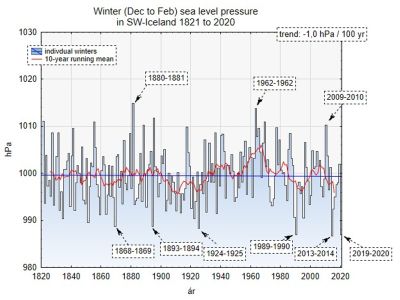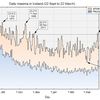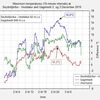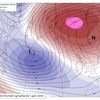Bloggfćrslur mánađarins, mars 2020
28.3.2020 | 19:55
Unusually high sea level pressure
An unusually intensive high-pressure system is now (28 March 2020) situated to the south of Iceland. The highest sea level pressure value (slp) observed in Iceland today was 1050.5 hPa - at the station Hjarđarland in the southern lowland. This is the highest slp observed in Iceland since 16 April 1991 (1050.8 hPa) and the second highest slp in the month of March. The record is 1051.7 hPa, measured at Vestmannaeyjar 6 March 1883.
It should be noted that still higher values were nominally noted in the central highlands, the highest value 1054.2 hPa at the station Setur [695 m a.s.l). This high value is a result of a dubious reduction of the pressure down to sea level in light winds and very low temperature (-19°C) and will thus not be confirmed as a record value.
Pressure values above 1050 hPa are only seldomly seen in Iceland. The record is 1058 hPa, measured in Reykjavik on 4 January 1841 (uncertainty probably about 2 hPa) and the second highest measured in Stykkishólmur 16 December 1917, 1053.3 hPa (but possibly 1054.0 hPa). There are 11 known instances of a higher value than the one reached today, 1 in April, 1 in March, 3 in February, 4 in January and 2 in December. In some of the cases the high values were measured at more than one station.
Bloggar | Slóđ | Facebook | Athugasemdir (0)
1.3.2020 | 23:03
Sea level pressure: Unusually low in Iceland this winter
The sea level pressure has been persistently low in Iceland since early December. Pressure has been recorded in Iceland during 200 winters (Dec to Feb) now. The present average is tied for the lowest of the whole series along with the values for the winter of 2013 to 2015 and 1989 to 1990. Due to some measurement uncertainties there are three earlier record contenders as well (see figure below).
The figure shows the December to February averages from 1820-1821 to 2019-2020 (columns) and a 10-year running mean as well (red trace). There is a very large year-to-year variability - much larger than the measurement uncertainty - this variability seems to be more or less random, although some clustering of high or low values is evident - as seen in the considerable variability of the 10-year mean. The overall trend (-1.0 hPa/century) is insignificant (smaller than the possible measurement bias in the series).
The sea level pressure in Iceland is a very good indicator of the state of both the NAO and AO indices. The positive excursions of the pressure are concurrent with the negative values of the indices. There is a very good correlation between the pressure and temperature anomalies in large parts of Europe - also during the early part of the series. This relationship is not fixed in time, however, there are other factors in play as well - as e.g. global warming.
Although the AO index is usually not calculated further back than 1950 there is no ground for supposing that the good relationship between it and the winter pressure in Iceland as only existed throughout this post 1950-period - but not earlier. Some long-term discrepancies are, however, likely.
[For a discussion of the series and reference see:
Jones, P.D., T. Jónsson, and D. Wheeler, (1997) Extension to the North Atlantic Oscillation using early instrumental pressure observations from Gibraltar and South-West Iceland, International J. of Climatology Vol.17, 1433-1450]
Bloggar | Slóđ | Facebook | Athugasemdir (0)
Um bloggiđ
Iceland Weather blog
Nýjustu fćrslur
- Unusually high temperatures
- Unusually high sea level pressure
- Sea level pressure: Unusually low in Iceland this winter
- A new national maximum temperature record for December
- A new sea level pressure record for June in Iceland
- An unusually warm April in Iceland
- A new October high pressure record in Iceland
- A new absolute September maximum temperature record in Iceland
Heimsóknir
Flettingar
- Í dag (9.10.): 0
- Sl. sólarhring:
- Sl. viku: 6
- Frá upphafi: 0
Annađ
- Innlit í dag: 0
- Innlit sl. viku: 6
- Gestir í dag: 0
- IP-tölur í dag: 0
Uppfćrt á 3 mín. fresti.
Skýringar



 hoskibui
hoskibui
 svatli
svatli




